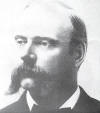| Friends Of The Little Bighorn Battlefield |
The Next Generation In The Study Of Custer's Last Stand |
Madden & Porter |
| • The Battle • Archeology • Memorials • Little Bighorn Store • News • Book Reviews |
Madden and Porter: Two Sides of Early War AmputationBy Berry CraigWebmaster's Note: Reprinted from "O & P Business News" magazine, March 15th issue, Copyright© 2005, SLACK Incorporated. All rights reserved. "O&P" serves the Orthotics (braces) and prosthetics (artificial limbs) industry. Author Berry Craig is from Mayfield, Kentucky and is a professor of history at the West Kentucky Community and Technical College in Paducah. He is also a freelance magazine writer and Associated Press columnist in his native Kentucky. Saddler Michael P. Madden gulped brandy before an Army surgeon amputated his right leg during the Battle of the Little Bighorn. The sawbones gave the Irish-born Kentucky enlistee another snort afterwards. "Supposedly, Madden was so appreciative of the second drink that he told the surgeon, Doctor, cut off me other leg," said Bob Reece, president of the Friends of the Little Bighorn Battlefield, a nonprofit group. Several sons of the Bluegrass State were in the famous 1876 fight that went down in history as "Custer's Last Stand." Madden, a Civil War veteran, rejoined the army at Louisville, Ky., in 1871. It evidently is not known if Madden was living in Louisville. He had been discharged at Mount Vernon, Ky., according to Reece. On June 25, 1876, Lt. Col. George Armstrong Custer and the Seventh Cavalry, 647-strong, attacked as many as 10,000 Sioux, Cheyenne and Arapaho — including approximately 2,000 warriors — encamped at the Little Bighorn River in southeastern Montana. Custer and about 40 percent of his men perished. The site of Custer's Last Stand is preserved as the Little Bighorn National Battlefield Monument near Crow Agency. Reece's group raises money and helps promote the national park. After killing Custer and the 209 men with him, the Indians pinned down the rest of the regiment on a grassy hilltop above the river. It was blazing hot. The soldiers soon emptied their canteens. On June 26, Madden and several other volunteers ran a gauntlet of Indian bullets and arrows to fetch water from the shallow river. A rifle slug hit Madden, 40, in the right leg, just above the ankle. Dr. Henry R. Porter braved a storm of Indian gunfire to amputate Madden's mangled limb. The 28-year-old civilian physician under contract to the Army reputedly used a collapsed tent for a ground cover and operating table. Dr. Henry PorterE.A. Brininstool included Madden's legendary quip in his book, "Troopers with Custer: Historic Incidents of the Battle of the Little Big Horn." The author quoted Pvt. William Slaper, another water carrier: "Before amputating ... the surgeon gave Mike a stiff horn of brandy to brace him up. Mike went through the ordeal without a whimper, and was given another drink. Smacking his lips in appreciation, he whispered to the surgeon, 'Doctor, cut off me other leg!'" Nineteen of the water carriers won Medals of Honor. For reasons not clear, Slaper and Madden did not. Madden, however, earned sergeant's stripes "for distinguished bravery in action." With the approach of Army reinforcements, the Indians retreated on the evening of June 26. Madden was placed on a litter and evacuated by mule. Once, the cantankerous critter balked and sent its human cargo thudding to the ground. Madden, who apparently suffered no further injury, eventually went by Bighorn River steamboat to Fort Lincoln, N.D., where he recovered. The Army discharged him in August, 1876, "as a sergeant of excellent character." Madden's date of death is apparently unknown, but he may be buried in the Fort Snelling National Cemetery in Minneapolis. Custer and part of the Seventh Cavalry spent 1871-1873 in Elizabethtown, Ky. He signed up soldiers in Elizabethtown and in Louisville. Battle Home |
|
Copyright 1999-2013 Bob Reece Friends Little Bighorn Battlefield, P.O. Box 636, Crow Agency, MT 59022 | Home |
Board of Directors |
Guest Book | Contact | Site Map
| |
